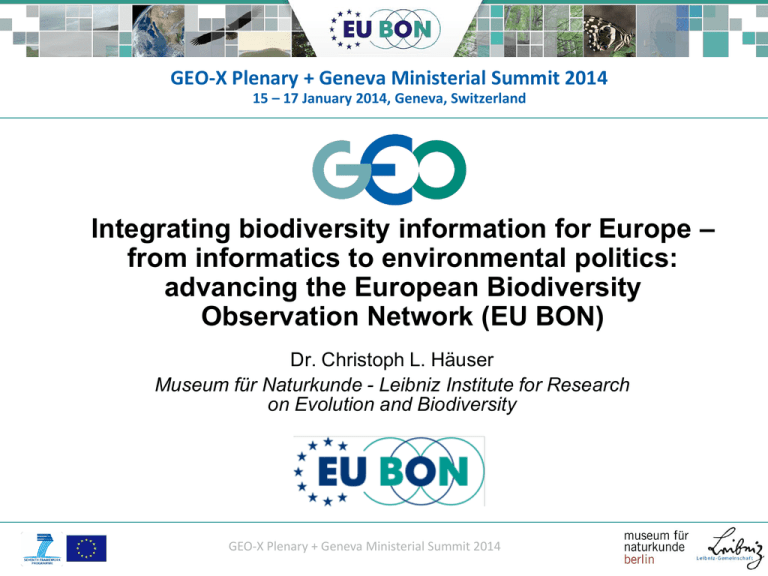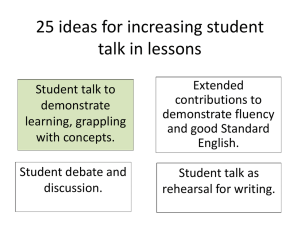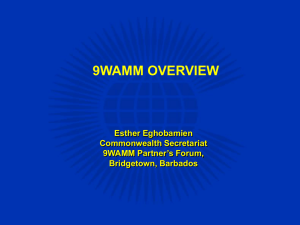Name: Presentation - Group on Earth Observations
advertisement

GEO-X Plenary + Geneva Ministerial Summit 2014 15 – 17 January 2014, Geneva, Switzerland Integrating biodiversity information for Europe – from informatics to environmental politics: advancing the European Biodiversity Observation Network (EU BON) Dr. Christoph L. Häuser Museum für Naturkunde - Leibniz Institute for Research on Evolution and Biodiversity GEO-X Plenary + Geneva Ministerial Summit 2014 Global challenges • Biodiversity loss, • Climate change, • Water & Food scarcity, • Poverty. The Knowledge Society is based on science and technology, i.e., the availability of sound & reliable scientific data, analysis and tools GEO-X Plenary + Geneva Ministerial Summit 2014 The Challenge: Integration of Biodiversity Information Freshwater Detailed Challenges: Terrestrial Marine Two realms: field (in situ) + remote sensing data + Data Standards, Interoperability, + Common Monitoring Schemes, + Analysis Tools, Patterns and Trends, Indicators, + Science Policy Interface(s), Dissemination GEO-X Plenary + Geneva Ministerial Summit 2014 EU BON - key information EC FP7 - Cooperation Theme 6 “Environment (incl. climate change)”. • Call ENV.2012.6.2-2: Assessing global biological resources: the European contribution to the Global Earth Observation Biodiversity Observation Network (GEO BON) • Project start: 1st December, 2012 • Duration: 54 months (until May 2017) • Projektkoordination: MfN, Berlin • Consortium: 30 partners (18 countries) • Budget: 11.6 mio Euro, < 9 mio Euro EC contribution GEO-X Plenary + Geneva Ministerial Summit 2014 Map: Johannes Penner EU BON Partners GEO-X Plenary + Geneva Ministerial Summit 2014 EU BON characteristics Key feature of EU BON: Delivery of integrated, near-real-time relevant data – both from onground observation and remote sensing – to the various stakeholders and end users ranging from local to global levels. The main objective of EU BON: Build a substantial part of the Group on Earth Observation’s Biodiversity Observation Network (GEO BON), also in light of the new Intergovernmental science-policy Platform on Biodiversity and Ecosystem Services (IPBES). GEO-X Plenary + Geneva Ministerial Summit 2014 EU BON – Meetings for the project kick-off First WP5 Meeting EU BON test site in Spain 2-4 April 2013, Doñana Biological Station • Goal: Sharing data among testing sites, principles and guidelines for establishing and operating EU BON test sites Informatics Task Force Meeting in Trondheim 29-31 May 2013, NBIC • Goal: Discussing data architectures, standards and interoperability for EU BON data portal First Stakeholder Roundtable in Brussels 18 June 2013, Leibniz Association • Goal: Determining policy needs in Europe regarding biodiversity information First WP4 Meeting Solsona 25-27 November 2013, Spain • Goal: Defining next steps for developing tools, methods, and analyses of biodiversity data Next General Meeting: EU BON in Crete, Greece 30.3. – 2.4. 2014 GEO-X Plenary + Geneva Ministerial Summit 2014 EU BON –Data Integration (WP2) EU BON will be implementing the GEO BON vision: • automated, streamlined data flow, from observations via EBVs, to indicators, • using a plug-and-play service-oriented approach, • coordinated through the GEO BON registry system • linked to the GEOSS Common Infrastructure, and transparent to users through portals GEO-X Plenary + Geneva Ministerial Summit 2014 EU BON – Plans for Biodiversity data portal (WP2) • • • • • User authentication and authorization Upload data: datasets & related metadata, different formats (DwC, EML, ABCD). Edit data and metadata (only allowed users). Search biodiversity occurrence (returning data from any connected data provider) Visualize data and metadata: • Grids, forms and maps. • Charts, statistics and reports. • Export and download: • Obtain statistics and EBV’s estimation from related data. GEO-X Plenary + Geneva Ministerial Summit 2014 Improving tools and methods for data analysis and interface (WP3 ) EU BON achievements for data analyis: • For advanced tools for interpreting satellite or aerial imagery: Assessment of available remote-sensing approaches. • Methods for analyzing datasets: • survey of existing spatial niche modeling approaches, • focus on a novel hierarchical classification algorithm for habitat classification, • species population downscaling approaches developed, • developing up-scaling approaches e.g. for plant - red lists, 3-dimentional “manifold” techniques, • enhanced version of Aquamaps software GEO-X Plenary + Geneva Ministerial Summit 2014 Science-policy dialogue (WP 6) EU BON – Using biodiversity data for policy: • Biodiversity data is often collected to support policy development, reporting and monitoring purposes at all levels • A large number of policies have reporting requirements • In addition, there are many processes which are biodiversity data hungry • Data and information is used both directly and indirectly • Being aware of the policy landscape will help: • Making the most out of existing data. The same data can be used to report to various policies and inform various processes. • Identify existing gaps. This will help to prioritize areas for further work and allocation of resources GEO-X Plenary + Geneva Ministerial Summit 2014 GEO-X Plenary + Geneva Ministerial Summit 2014 Ecosystem Accounting UNCCD ITPGRF CBD UNFCC C Green Economy Barcelon a Helsinki Bucharest CMS CITES Antarctic Ramsar IPPC OSPA R WHC Regional seas Water Conv. MEAs Assessments Genetic resources IPCC ITTA Espoo ICR W Bern IPBES MDGs/SDGs WOA Alpine Florence Carpathia n Pan-European strategy FRA GEO EU level RD priorities CFP Nitrates Directive CAP EIA Directive ELD Kyiv (SEA) Protocol WFD MSFD Wildlife Trade Regulation s Floods Directive Habitats Directive IAS Directive EU Biodiversity Strategy GEO-X Plenary + Geneva Ministerial Summit 2014 Birds Directiv e GMO Directiv e EU BON dissemination strategy (WP8) Flow chart showing how multiple uses will be made of project results for dissemination and knowledge transfer purposes. GEO-X Plenary + Geneva Ministerial Summit 2014 Dissemination and outreach (WP8) 67 news items (news and events) published on the website 4 press releases and 2 interviews published EU BON presented at 32 conferences and workshops Website statistics for 2013: 11 079 visits, 5939 unique visitors, 49 416 page views www.eubon.eu GEO-X Plenary + Geneva Ministerial Summit 2014 EU BON – Scientific Papers Planned scientific papers of EU BON partners: I) Big data for biodiversity – challenges and opportunities for integration II) Availability/usability of - integrated - biodiversity information: challenges and opportunities for IPBES III) Biodiversity recording and information management in Europe – state of the art and prospects IV) Can EBVs deliver what they promise: monitoring of biodiversity targets V) Global DNA-derived datasets and taxonomy GEO-X Plenary + Geneva Ministerial Summit 2014 Thank you very much for your attention and to all EU BON partners & associates !!! www.eubon.eu GEO-X Plenary + Geneva Ministerial Summit 2014 GEO-X Plenary + Geneva Ministerial Summit 2014 What can EBVs deliver? EU 2020 Target 1 Fully implement the Birds and Habitats Directives: To halt the deterioration in the status of all species and habitats covered by EU nature legislation and achieve a significant and measurable improvement in their status so that, by 2020, compared to current assessments. Relevant EBVs • Genetic composition (co-ancestry, allelic diversity, population genetic differentiation), • Species population (Species distribution and Population abundance), • Species traits (Migratory behaviour) • Community composition (Taxonomic diversity) and • Ecosystem structure (Habitat structure and ecosystem extent and fragmentation) Data availability for • all biomes: terrestrial, fresh water and marine • geographical coverage • specific taxa • common versus rare species • Time series Existing knowledge and data gaps GEO-X Plenary + Geneva Ministerial Summit 2014 EU BON dissemination strategy Figure 2. The following scheme illustrates the EU BON Social Media Strategy workflow. GEO-X Plenary + Geneva Ministerial Summit 2014 EU BON Work Packages WP1: Data sources: requirements, gap analysis & data mobilization [University Tartu]; WP2: Data integration & interoperability [Univ Eastern Finland - Digitarium]; WP3: Improving tools and methods for data analysis & interface [Univ Leeds]; WP4: Link environment to biodiversity: analyses of patterns, processes & trends [UFZ]; WP5: EU BON testing and validation of concepts, tools, and services [CSIC]; WP6: Stakeholder engagement & science-policy dialogue [Univ Cambridge]; WP7: Implementation of GEO BON: strategies & solutions at European (& global) levels [CNRS: IMEB]; WP8: Dissemination and outreach [Pensoft]; WP9: Consortium management & organization [MfN]. GEO-X Plenary + Geneva Ministerial Summit 2014 EU BON Workflow und Organization GEO-X Plenary + Geneva Ministerial Summit 2014 Linking biodiversity information stakeholders: EU BON Associates - and growing … GEO-X Plenary + Geneva Ministerial Summit 2014 Linkage to projects and processes GEOSS GEO-X Plenary + Geneva Ministerial Summit 2014






